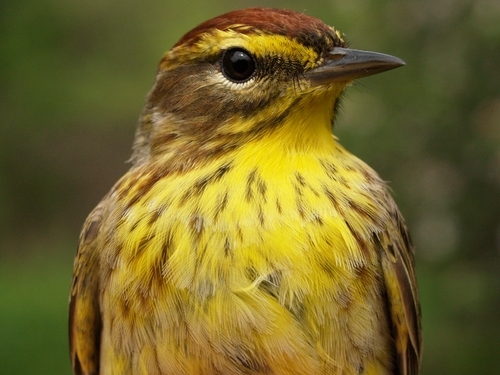|
|
THIS WEEK |
THIS SPRING |
2010 TOTAL |
SITE TOTAL |
|
# birds (and species) banded |
37 (18) |
227 (25) |
350 (27) |
23859 (105) |
|
# birds (and species) repeat |
9 (4) |
47 (11) |
77 (10) |
4418 (66) |
|
# birds (and species) return |
12 (8) |
37 (14) |
46 (12) |
666 (37) |
|
# species observed |
82 |
105 |
108 |
200 |
|
# net hours |
421.0 |
1375.4 |
1441.4 |
41348.6 |
|
# birds banded / 100 net hours |
17.5 |
16.5 |
24.3 |
57.7 |
|
|
Note: table does not include nocturnal banding (owls) |
Banders-in-charge: Simon Duval, Gay Gruner
Assistants: Christine Barrie, Mike Beaupré, Christine Burt, Adriana Celada, Jean Demers, Connie Downes, David Davey, Rejean Duval, Isaac Finkelstein, Max Finkelstein, Nicki Fleming, Barbara Frei, Jeff Harrison, Marie-Anne Hudson, Marie-France Julien, Malcolm Johnson, Barbara MacDuff, Betsy McFarlane, Chris Murphy, Mark Romer, Bonnie Soutar, Rodger Titman, Clémence Soulard, Vince Spinelli
Notes: Once again weather conditions played havoc with our spring migration monitoring program. Even with snow, high winds, cold temperatures and rain (yes, this is the first week of May) we managed to have the nets open 412 of a possible 560 net hours. Despite the challenging conditions for both birds and humans, we added 28 species to the spring and year lists: Cackling Goose, Blue-winged Teal, Green Heron, Northern Goshawk, Common Moorhen, Solitary Sandpiper, Spotted Sandpiper, Great-crested Flycatcher, Eastern Kingbird, Blue-headed Vireo, Warbling Vireo, Red-eyed Vireo, Northern Rough-winged Swallow, Winter Wren, Veery, Wood Thrush, Tennessee Warbler, Nashville Warbler, Yellow Warbler, Magnolia Warbler, Black-throated Blue Warbler, Black-throated Green Warbler, Palm Warbler, Black-and-white Warbler, Ovenbird, Eastern White-crowned Sparrow, Indigo Bunting and Baltimore Oriole.
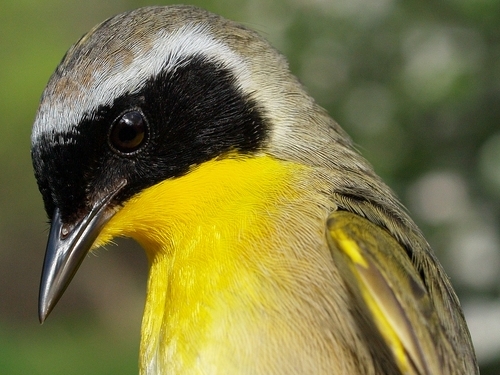
Some nice bright colours of spring - Common Yellowthroat above, and Baltimore Oriole below, both males.
(Photos by Simon Duval)
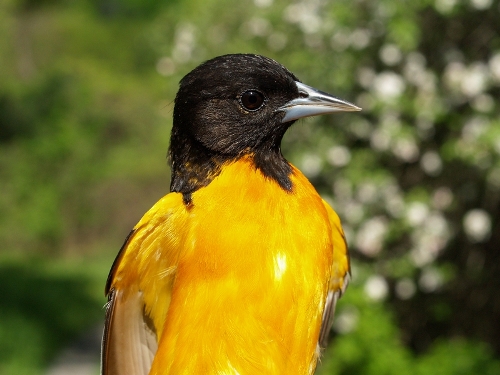
|
Seven new species were banded this week: Warbling Vireo, Nashville Warbler, Black-throated Blue Warbler, Yellow-rumped Warbler, Palm Warbler, Common Yellowthroat, and Eastern White-crowned Sparrow. Despite this promising list, activity in the nets remains slow and has us scratching our heads. Migration is unusual this year, to say the least. Fat levels on our Ruby-crowned Kinglets and White-throated Sparrows were high, a sign that they are ready for the next leg of their trip to the Boreal. We hope they will have a productive breeding season and return en masse in the fall.
This week’s
top 10 (last week's top 10 in brackets)
#
individuals banded |
mean # individuals observed daily |
1. Ruby-crowned Kinglet (5) [2] |
1. Canada Goose (328) [1] |
1. Red-winged Blackbird (5) [1] |
2. Red-winged Blackbird (41) [2] |
3. White-throated Sparrow (4) [6] |
3. Cliff Swallow (23) [-] |
4. Tree Swallow (2) [6] |
4. Cedar Waxwing (18) [4] |
4. American Robin (2) [8] |
5. American Crow (16) [-] |
4. Nashville Warbler (2) [-] |
6. American Goldfinch (15) [8] |
4. Yellow-rumped Warbler (2) [-] |
7. Tree Swallow (15) [5] |
4. Common Yellowthroat (2) [-] |
8. Ring-billed Gull (13) [-] |
4. Song Sparrow (2) [-] |
9. Black-capped Chickadee (12) [6] |
4. Common Grackle (2) [10] |
10. Blue Jay (11) [-] |
|
The top ten species banded this week is a meager list. The total count of 37 is a record low for week 6 of spring, and all the more remarkable is that all species were scarce - in previous years, the smallest ever count for the week's top bird was 13 individuals banded!
Once again Canada Goose is the top bird observed by a large margin, as has been the case in week 6 for four of the previous five years as well. New in the top ten observed list this week are Cliff Swallow, American Crow, Ring-billed Gull and Blue Jay. Cliff Swallows numbers have swelled considerably since their arrival at the Radar Station during Week 4, the gulls have been attracted by the tilling of the farm fields southeast of MBO, large flocks of Blue Jays have been observed, signaling a possible migration, and who can ever explain the movement patterns of American Crows? Suffice it to say that they fly purposefully from compass point to compass point, but we can not really discern the reasons behind their movements.
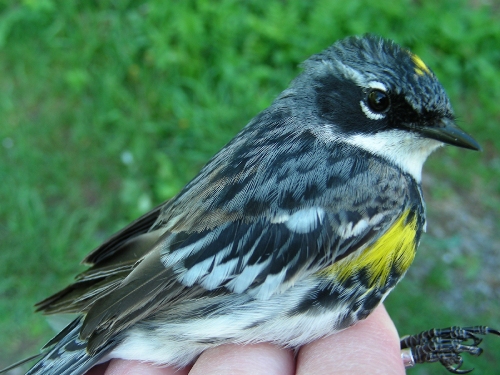
One of the few northbound Yellow-rumped Warblers so far this spring; we hope to see much larger numbers this fall. (Photo by Simon Duval)

A pair of Blue-winged Teal hanging out in the back pond, along with a couple of Painted Turtles in the background. (Photo by Simon Duval)
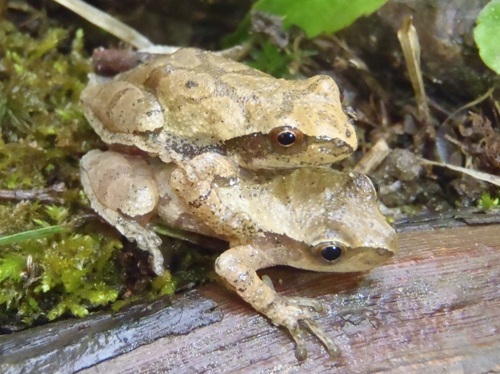
A pair of Spring Peepers caught in a moment of passion during a recent amphibian survey at MBO (Photo by Amélie Perez)
|

